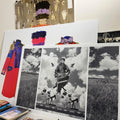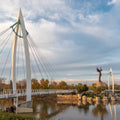New Deep Ellum Community Center in Dallas shares legacy of historic rail crossroads
By Medicine Man Gallery on

Guest enjoying an exhibition at Deep Ellum Community Center | Photo by Kevin Huckabee
In the shadow of Dallas’ downtown skyscrapers, a railroad crossroads tells a fascinating story. Many of them. When the Texas and Pacific line crossed the Houston and Texas Central in 1873, Deep Ellum was created.
In those years, Dallas was a hub for the cotton industry and railroads brought cotton grown across the state to Big D for processing and distribution around the nation. What oil would become to Texas in the 20th century, cotton was in the 19th.
The boll weevil put an end to that.
The insect was introduced in America near Brownsville, TX in the early 1890s and within a generation, had nearly ruined cotton production across the state.
Dallas was forced to diversify its business interests, becoming a regional commercial center. The crossroads grew.
“During the period of the 1890s up until 1916, the Union Depot was on that side of (Dallas) and so it was little businesses that grew up around the train station and extended into blocks of Elm Street which were referred to as Deep Ellum,” Alan Govenar, author of “Deep Ellum and Central Track: Where the Black and White Worlds of Dallas Converged,” explains. “The Black community at that time was mainly concentrated around Central Avenue, which was also called Central Track. It was the little shanty town that grew up along the right of way of the railroad, the easements.”
Prior to the railroads, what became Deep Ellum had been a freedman town.
“It’s amazing how Black business was flourishing and growing up until, in Dallas, 1916, when the first Jim Crow laws were instituted that mandated segregation,” Govenar adds.
That story repeated itself across America.
Indiana Avenue in Indianapolis. Greenwood in Tulsa. Chicano Park in San Diego.
Thriving Black communities wrecked by racial segregation, racist laws, anti-Black violence.
In Deep Ellum, however, when the Ku Klux Klan took over Dallas in the 1920s, something strange happened. A period of vitality that would come to define the district as a creative center began.
“Dallas in the mid-1920s was a recording hub,” Govenar said. “The most seminal, downhome blues singer of the 1920s was Blind Lemon Jefferson who stood near the corner of Elm Street and Central Avenue busking for tips. He was originally from East Texas, and he was discovered in that area by a Paramount recording scout. Between 1925 and his untimely death in 1929, he made in excess of 90 recordings.”
He wasn’t alone.
“There were other musicians who were discovered and recorded in hotel rooms (in Deep Ellum) and makeshift recording sessions from early Western Swing to the hillbilly bands, jazz, women, classic blues singers,” Govenar adds.
Bob Wills. The Light Crust Doughboys.
In the 1930s, Warner Brothers built a studio nearby Deep Ellum producing hundreds of recordings.
“Robert Johnson did his last sessions there and many people consider his Dallas recordings to be some of his most important,” Govenar said.
What is Deep Ellum?
That’s Deep Ellum.

'Invisible Deep Ellum' poster recreation of historic Black business advertisement| Photo by Alan Govenar
Deep Ellum at 150
Deep Ellum turns 150 years old in 2023 and having just received its national historic designation, the district unveiled the Deep Ellum Community Center on September 30. The center will be a gathering place for the community, house local nonprofit and arts organizations including the Deep Ellum Foundation, Deep Ellum Community Association, and Deep Ellum Radio, and offer steeply subsidized workspace to burgeoning artists and entrepreneurs of color coupled with mentorship and educational programming. These organizations will host regular community meetings, workshops, and recording sessions within the Center as well as district tours.
A permanent exhibition curated by Govenar, “When You Go Down in Deep Ellum,” brings to life stories of Deep Ellum through the district’s themes spanning its entire history: migration, music, business and commerce, and art and culture. It will highlight Deep Ellum’s vast musical legacy with a listening room and operational 78 rpm recording studio – the first of its kind in the nation.
Deep Ellum Community Center’s inaugural temporary exhibition, “Unlikely Blues,” presents the illustrations of Chicago artist Louis Paeth, who designed “Race Record” ads that were made to promote early blues artists, most notably Jefferson.
Just down from the Center on Elm Street underneath the I-345 overpass will be the Center’s outdoor installation, “Invisible Deep Ellum.” Utilizing the concrete columns beneath the interstate and North Central Expressway, “Invisible Deep Ellum” features advertisements and selected pages from 1911 and 1925 Black business directories that document the former vitality of Deep Ellum, interspersed with comments by community leaders, African Americans, and whites who worked in the area.
Here, Deep Ellum’s story takes another surprising turn. An area of Elm Street featured secondhand shops and pawn shops run by immigrant Jews fleeing oppression and murderous pogroms in Russia, Ukraine and Eastern Europe in the 1920s and 30s.
You can imagine Klan-run Dallas wasn’t keen on their presence either.
“Cultures converged by necessity. It wasn't that Dallas welcomed cultural mixing. The people who came there were generally low income, and to survive, they had to get along. They had to figure out a way to work with each other,” Govenar said. “The Jewish pawn shops became bankers for poor Blacks who couldn't get regular bank loans.”
Stephanie Keller Hudiburg, Executive Director of the Deep Ellum Foundation, looks forward to the Community Center making locals and visitors alike aware of this history, and learning from it.
“The beautiful thing about Deep Ellum is what that history highlights. It's a history that highlights people coming together – largely out of necessity – but nonetheless coming together – a diverse cross section – and creativity being spawned from that,” she said. “The creative ethos that we have here in the district is the gift that keeps on giving. You could be in food and beverage, but be inspired by the history. We have architecture and design shops – in fact a cluster of them, I would say much more than people realize – because they want to be close to this environment that inspires them. I think that's the true beauty of it.”
Deep Ellum is thriving today with over 400 businesses, almost half independently owned and operated.
“We hope the Community Center will continue to inspire that culture, that entrepreneurialism,” Keller Hudiburg added.

Members of the contemporary lineup of the Light Crust Doughboys perform at the Deep Elleum Community Center grand opening | Photo by Kevin Huckabee
Deep Ellum Today
Shaped by the railroads. By environmental catastrophe. By African Americans. By racism and Jim Crow. By immigration. By the atrocity of Urban Renewal. By increasing gentrification. Deep Ellum stands as a metaphor for urban change and growth and the dilemma of urban America according to Govenar.
“It's a neighborhood very much in flux,” he said. “Across the street from the Deep Ellum Community Center (are) luxury condos. On that same block, the 2500 block of Elm Street, is a very important building built as the headquarters for the Colored Knights of Pythias, a fraternal lodge. Finally, this building has been restored. It's become a Kimpton boutique hotel; I think they've done a good job trying to restore the facade of this building and to preserve its architectural integrity. It's a building that was designed by William Sidney Pittman who was the first Black architect in Texas.”
The Kimpton Pittman Hotel is one of countless fashionable businesses in the area that could give the neighborhood a “hipster” distinction. Coffee shops, noodle restaurants, boutiques. There are murals everywhere. People out walking.
Deep Ellum is “cool.”
Blind Lemon Jefferson, Bob Wills and Robert Johnson cool.



